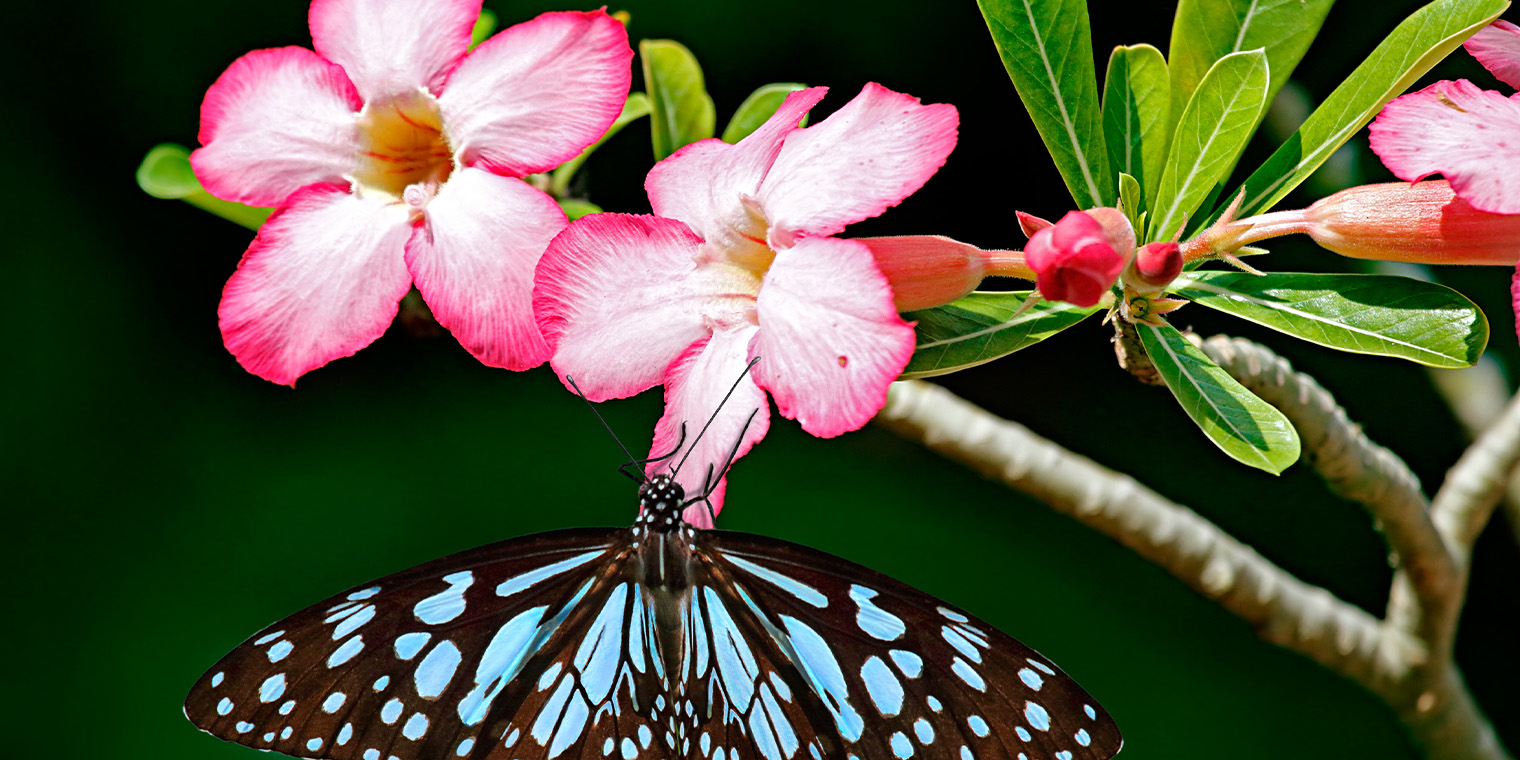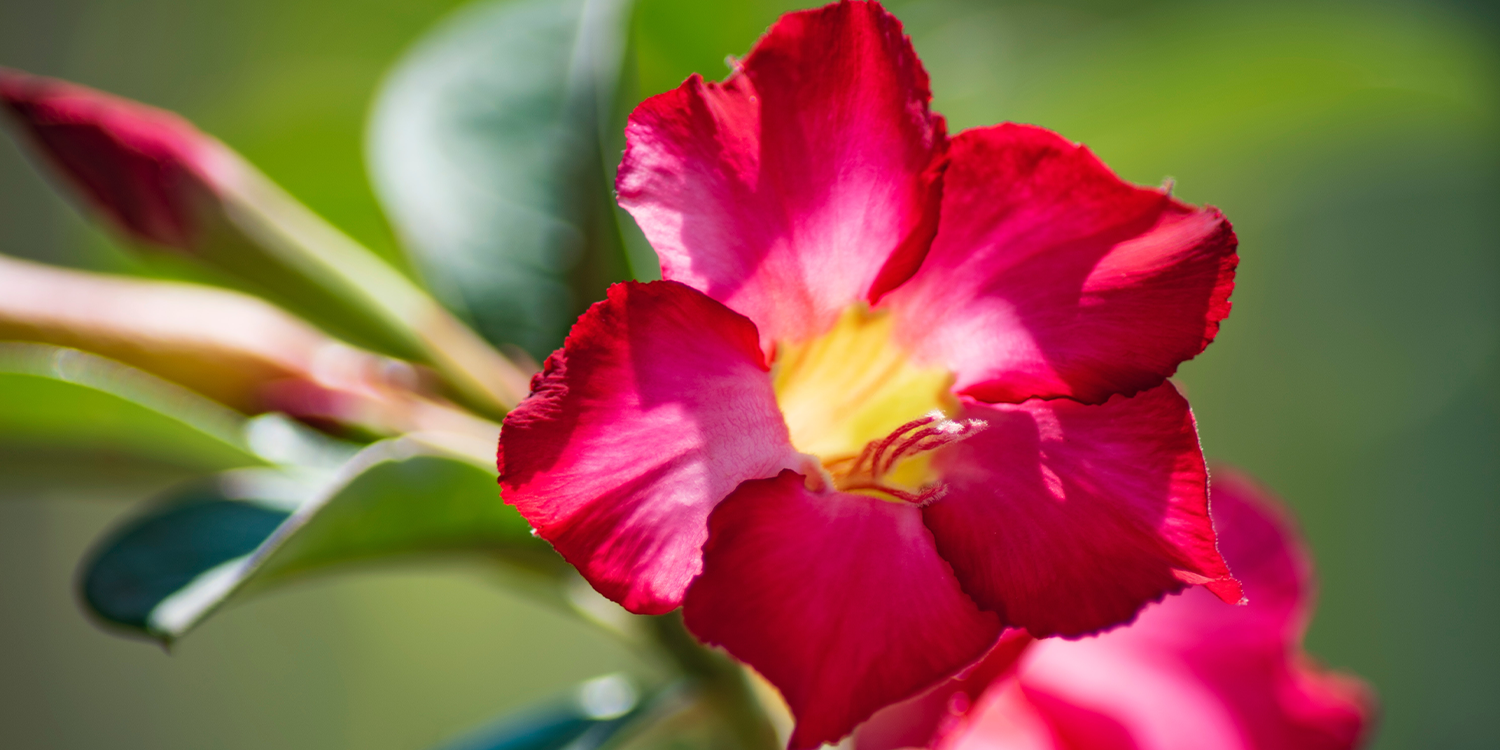These iconic southern flowers brighten up desert landscapes with their distinctive clusters of tubular blossoms in bold shades of red, pink, yellow, and white. They can grow as shrubs or small trees, reaching heights of up to 6 feet here in Florida. While they’re a bit of a slow grower, their impressive displays of foliage and flora are well worth the wait. To cultivate your own desert rose plants, follow these steps to make sure this next gardening endeavor is successful.
Please note: the sap in desert roses can be an irritant to some people’s skin.
Planting Desert Rose in the Ground
When selecting a place to plant your desert rose bush, make sure you’re looking for a spot with lots of sun. Desert roses need at least 6 hours of direct sunlight every day (they are desert dwellers, after all). While they are quite tolerant to the scorching hot temperatures of the South and aren’t particularly vulnerable to drought, they perform best in sandy, well-draining soil, so check your soil quality to make sure it’s draining nicely. Desert roses are pretty sensitive to root rot from sitting in stagnant water, so keep them away from automatic sprinkler systems.
Desert roses planted in the ground should be fertilized twice a year: once in March and once in October. Use a balanced 10-10-10 granular fertilizer and sprinkle it all around the soil, being careful not to get any on the leaves of the plant. To figure out how much fertilizer you need, typically a half cup of fertilizer for every foot of your rose bush height should do it— so if your plant is three feet tall, use one and a half cups of fertilizer granules. Water the soil after your fertilizer application. To promote more blooms, you can use a liquid fertilizer in summer.

How to Grow Desert Rose Plants in Containers
Desert roses are also very successful as container plants. They can still grow to pretty impressive sizes if you continually re-pot them into larger planters as they expand. Make sure your container has drainage holes in the bottom to avoid root rot. Use a potting mix for succulents to ensure good drainage. Keep the plants in a nice sunny spot, and if an unexpected cold spell drops temperatures below 35 degrees Fahrenheit, bring your rose plant indoors so it doesn’t end up losing its leaves.
Fertilize container-grown desert roses every two months by sprinkling a few heaping tablespoons of 10-10-10 fertilizer across the soil, and then watering. Wipe off any fertilizer if it makes contact with the leaves. Allow the soil to dry out between waterings.
When to Prune Desert Rose in Florida
You really only need to do one big prune of your desert rose bush once per year. Prune in late February or early March, just as new growth emerges and before the blossoms start to appear. Late-season pruning can make your plant more susceptible to damage from winter cold, but we don’t have to worry about cold temperatures too often here in South Florida.
Prune off any stems that jut out awkwardly and extend past the leaves to help your plant grow thick and bushy. Any damaged branches should be nipped off as well to promote new, healthy growth.

Desert Rose Growing Tips
There are a few things you should definitely keep in mind when caring for desert roses. Most importantly, the sap inside the plant stems is quite toxic if ingested, so adequate safety measures are necessary when working with your plant.
Always wear waterproof gloves when pruning or transplanting. This will protect your skin from the harmful effects of the plant sap.
Sterilize all pruning equipment thoroughly after use. Not only will this wash away the plant sap, but it will help prevent the development of bacteria on your tools that could harm other plants through cross-contamination. If you’re cutting out damaged or diseased parts of a rose bush, sterilize your tools with alcohol after every cut.
Keep an eye out for foliage fungus during periods of high humidity. If you see any speckles or fuzzy white buildup on your desert rose leaves, cut out the diseased parts as soon as you can.
So long as your desert roses have lots of sun and sandy soil that drains quickly, you shouldn’t have to worry too much about day-to-day maintenance of your shrubs. They’re pretty easy to keep happy and don’t require a ton of extra effort— just make sure you protect your skin from its caustic sap!

